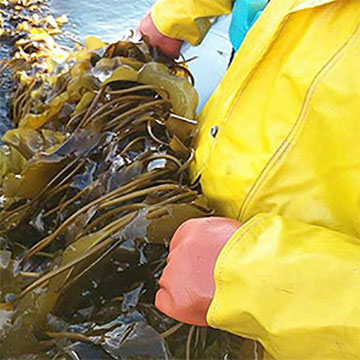
Alaska Shellfish Growers Learn about Seaweed Farming
December 18, 2015
At the workshop, Maine-based seaweed grower Paul Dobbins presented an overview of kelp farming from spore to plate including farming setup, and Beau Perry, of Premium Oceanic in California, explained how his company is investing in seaweed growing in Alaska. Mike Stekoll, algae researcher at the University of Alaska Southeast, summarized his experiments with growing several seaweed species in Alaska over the last 25 years. Alaska Sea Grant’s project is supporting commercial seaweed pilot projects on shellfish farms in Alaska, to test growing conditions, economic feasibility, and logistics. Farmers will have the opportunity to acquire kelp propagation starters as early as 2016. OceansAlaska in Ketchikan is seeding longlines with kelp species native to Alaska and will provide them to growers, who can suspend the lines under water from buoys. “OceansAlaska is going to provide the string to propagate the algae,” said Gary Freitag, Marine Advisory agent and one of the project leaders. “We can’t use algae from back East—it wouldn't be legal. You have to have indigenous seed in order to raise seaweed in Alaska.” Alaska’s south coast has a broad variety of edible species. Many of them could be used to make the nori sheets used for sushi, Beau Perry said. Perry encouraged Alaska farmers to raise seaweed at their farms as a pilot project, with the possibility of growing seaweed for his company in the future. He cited the advantages of farming algae, which grows rapidly and matures much faster than oysters or mussels, and can be harvested multiple times in a growing season. In addition, after it is dried, seaweed can remain edible for years. Perry sees great potential for seaweed farming in Alaska’s cold, clean waters, and believes there is a huge market for it. Growers have responded positively to the project. “The farmers were very enthusiastic about trying it,” said Gary Freitag. “I'm getting lots of non-farmers calling me with interest in doing it as well, which is a good sign.”
Edited by Mary Kauffman, SitNews
Source of News:
|
|||
